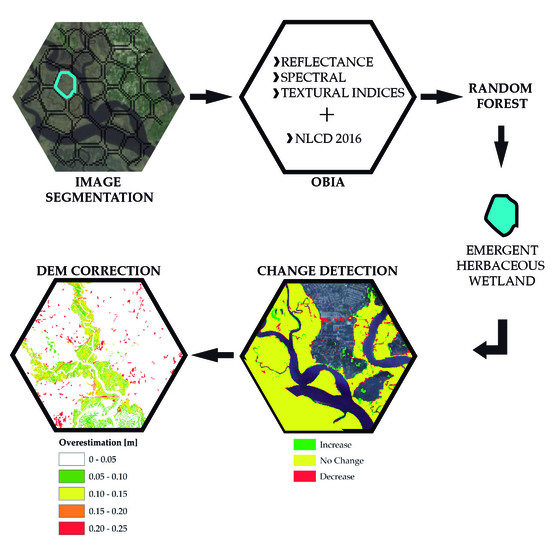Adjusting Emergent Herbaceous Wetland Elevation with Object-Based Image Analysis, Random Forest and the 2016 NLCD
Abstract
1. Introduction
2. Materials and Methods
2.1. Study Area
2.2. Data
2.3. Imagery Preprocessing
2.4. Updating Emergent Wetland Regions
2.4.1. Image Segmentation with OBIA
2.4.2. Feature and Land Cover Class Extraction
2.4.3. Training and Validation with Random Forest
2.5. Adjusting Emergent Wetland Surface Elevation
Implementation of the DEM-Correction Tool
3. Results
3.1. Optimal Hyperparameter Values
3.2. Accuracy Assessment of Land Cover Classification
3.3. Emergent Wetland Classification in the 2019 Imagery
3.4. Adjusting Emergent Wetland Surface Elevation in DEMs
DEM-Correction Accuracy Assessment
4. Discussion
5. Conclusions
Author Contributions
Funding
Acknowledgments
Conflicts of Interest
References
- Mcowen, C.J.; Weatherdon, L.V.; Van Bochove, J.-W.; Sullivan, E.; Blyth, S.; Zockler, C.; Stanwell-Smith, D.; Kingston, N.; Martin, C.S.; Spalding, M. A global map of saltmarshes. Biodivers. Data J. 2017, 5, e11764. [Google Scholar] [CrossRef] [PubMed]
- Costanza, R.; d’Arge, R.; de Groot, R.; Farber, S.; Grasso, M.; Hannon, B.; Limburg, K.; Naeem, S.; O’Neill, R.V.; Paruelo, J.; et al. The value of the world’s ecosystem services and natural capital. Nature 1997, 387, 253. [Google Scholar] [CrossRef]
- Barbier, E.B. Chapter 27—The Value of Coastal Wetland Ecosystem Services. In Coastal Wetlands; Perillo, G.M.E., Wolanski, E., Cahoon, D.R., Hopkinson, C.S., Eds.; Elsevier: Amsterdam, The Netherlands, 2019; pp. 947–964. ISBN 978-0-444-63893-9. [Google Scholar]
- Mitsch, W.J.; Gosselink, J.G. The value of wetlands: Importance of scale and landscape setting. Ecol. Econ. 2000, 35, 25–33. [Google Scholar] [CrossRef]
- Medeiros, S.; Hagen, S.; Weishampel, J.; Angelo, J. Adjusting Lidar-Derived Digital Terrain Models in Coastal Marshes Based on Estimated Aboveground Biomass Density. Remote Sens. 2015, 7, 3507–3525. [Google Scholar] [CrossRef]
- Rogers, J.N.; Parrish, C.E.; Ward, L.G.; Burdick, D.M. Assessment of Elevation Uncertainty in Salt Marsh Environments using Discrete-Return and Full-Waveform Lidar. J. Coast. Res. 2016, 107–122. [Google Scholar] [CrossRef]
- Leonardi, N.; Carnacina, I.; Donatelli, C.; Ganju, N.K.; Plater, A.J.; Schuerch, M.; Temmerman, S. Dynamic interactions between coastal storms and salt marshes: A review. Geomorphology 2018, 301, 92–107. [Google Scholar] [CrossRef]
- Alizad, K.; Hagen, S.C.; Medeiros, S.C.; Bilskie, M.V.; Morris, J.T.; Balthis, L.; Buckel, C.A. Dynamic responses and implications to coastal wetlands and the surrounding regions under sea level rise. PLoS ONE 2018, 13, e0205176. [Google Scholar] [CrossRef] [PubMed]
- Schile, L.M.; Callaway, J.C.; Morris, J.T.; Stralberg, D.; Parker, V.T.; Kelly, M. Modeling Tidal Marsh Distribution with Sea-Level Rise: Evaluating the Role of Vegetation, Sediment, and Upland Habitat in Marsh Resiliency. PLoS ONE 2014, 9, e88760. [Google Scholar] [CrossRef]
- Callaway, J.C.; DeLaune, R.D.; Patrick, W.H., Jr. Sediment Accretion Rates from Four Coastal Wetlands along the Gulf of Mexico. J. Coast. Res. 1997, 13, 181–191. [Google Scholar]
- Morris, J.T.; Sundareshwar, P.V.; Nietch, C.T.; Kjerfve, B.; Cahoon, D.R. Responses of Coastal Wetlands to Rising Sea Level. Ecology 2002, 83, 2869–2877. [Google Scholar] [CrossRef]
- Day, J.; Ibáñez, C.; Scarton, F.; Pont, D.; Hensel, P.; Day, J.; Lane, R. Sustainability of Mediterranean Deltaic and Lagoon Wetlands with Sea-Level Rise: The Importance of River Input. Estuaries Coasts 2011, 34, 483–493. [Google Scholar] [CrossRef]
- Alizad, K.; Hagen, S.C.; Morris, J.T.; Medeiros, S.C.; Bilskie, M.V.; Weishampel, J.F. Coastal wetland response to sea-level rise in a fluvial estuarine system. Earths Future 2016, 4, 483–497. [Google Scholar] [CrossRef]
- Schieder, N.W.; Walters, D.C.; Kirwan, M.L. Massive Upland to Wetland Conversion Compensated for Historical Marsh Loss in Chesapeake Bay, USA. Estuaries Coasts 2018, 41, 940–951. [Google Scholar] [CrossRef]
- Feagin, R.A.; Martinez, M.L.; Mendoza-Gonzalez, G.; Costanza, R. Salt Marsh Zonal Migration and Ecosystem Service Change in Response to Global Sea Level Rise: A Case Study from an Urban Region. Ecol. Soc. 2010, 15, 14. [Google Scholar] [CrossRef]
- Kirwan, M.L.; Walters, D.C.; Reay, W.G.; Carr, J.A. Sea level driven marsh expansion in a coupled model of marsh erosion and migration. Geophys. Res. Lett. 2016, 43, 4366–4373. [Google Scholar] [CrossRef]
- Yang, L.; Jin, S.; Danielson, P.; Homer, C.; Gass, L.; Bender, S.M.; Case, A.; Costello, C.; Dewitz, J.; Fry, J.; et al. A new generation of the United States National Land Cover Database: Requirements, research priorities, design, and implementation strategies. ISPRS J. Photogramm. Remote Sens. 2018, 146, 108–123. [Google Scholar] [CrossRef]
- Cowardin, L.M.; Carter, V.; Golet, F.C.; Laroe, E.T. Classification of Wetlands and Deepwater Habitats of the United States. In Water Encyclopedia; Lehr, J.H., Keeley, J., Eds.; John Wiley & Sons, Inc.: Hoboken, NJ, USA, 2013; p. sw2162. ISBN 978-0-471-47844-7. [Google Scholar]
- Lebourgeois, V.; Dupuy, S.; Vintrou, É.; Ameline, M.; Butler, S.; Bégué, A. A Combined Random Forest and OBIA Classification Scheme for Mapping Smallholder Agriculture at Different Nomenclature Levels Using Multisource Data (Simulated Sentinel-2 Time Series, VHRS and DEM). Remote Sens. 2017, 9, 259. [Google Scholar] [CrossRef]
- Campbell, A.; Wang, Y. High Spatial Resolution Remote Sensing for Salt Marsh Mapping and Change Analysis at Fire Island National Seashore. Remote Sens. 2019, 11, 1107. [Google Scholar] [CrossRef]
- Phiri, D.; Morgenroth, J.; Xu, C.; Hermosilla, T. Effects of pre-processing methods on Landsat OLI-8 land cover classification using OBIA and random forests classifier. Int. J. Appl. Earth Obs. Geoinf. 2018, 73, 170–178. [Google Scholar] [CrossRef]
- Phiri, D.; Morgenroth, J. Developments in Landsat Land Cover Classification Methods: A Review. Remote Sens. 2017, 9, 967. [Google Scholar] [CrossRef]
- Cooper, H.M.; Zhang, C.; Davis, S.E.; Troxler, T.G. Object-based correction of LiDAR DEMs using RTK-GPS data and machine learning modeling in the coastal Everglades. Environ. Model. Softw. 2019, 112, 179–191. [Google Scholar] [CrossRef]
- Ma, L.; Li, M.; Ma, X.; Cheng, L.; Du, P.; Liu, Y. A review of supervised object-based land-cover image classification. ISPRS J. Photogramm. Remote Sens. 2017, 130, 277–293. [Google Scholar] [CrossRef]
- Robertson, L.D.; King, D.J. Comparison of pixel- and object-based classification in land cover change mapping. Int. J. Remote Sens. 2011, 32, 1505–1529. [Google Scholar] [CrossRef]
- Breiman, L. Random Forests. Mach. Learn. 2001, 45, 5–32. [Google Scholar] [CrossRef]
- Wang, X.; Gao, X.; Zhang, Y.; Fei, X.; Chen, Z.; Wang, J.; Zhang, Y.; Lu, X.; Zhao, H. Land-Cover Classification of Coastal Wetlands Using the RF Algorithm for Worldview-2 and Landsat 8 Images. Remote Sens. 2019, 11, 1927. [Google Scholar] [CrossRef]
- Li, C.; Wang, J.; Wang, L.; Hu, L.; Gong, P. Comparison of Classification Algorithms and Training Sample Sizes in Urban Land Classification with Landsat Thematic Mapper Imagery. Remote Sens. 2014, 6, 964–983. [Google Scholar] [CrossRef]
- Campbell, A. Monitoring Salt Marsh Condition and Change with Satellite Remote Sensing. Open Access Dissertations. Available online: https://digitalcommons.uri.edu/oa_diss/793 (accessed on 20 August 2019).
- Millard, K.; Redden, A.M.; Webster, T.; Stewart, H. Use of GIS and high resolution LiDAR in salt marsh restoration site suitability assessments in the upper Bay of Fundy, Canada. Wetl. Ecol Manag. 2013, 21, 243–262. [Google Scholar] [CrossRef]
- Brock, J.C.; Purkis, S.J. The Emerging Role of Lidar Remote Sensing in Coastal Research and Resource Management. J. Coast. Res. 2009, 25, 1–5. [Google Scholar] [CrossRef]
- Zhao, X.; Su, Y.; Hu, T.; Chen, L.; Gao, S.; Wang, R.; Jin, S.; Guo, Q. A global corrected SRTM DEM product for vegetated areas. Remote Sens. Lett. 2018, 9, 393–402. [Google Scholar] [CrossRef]
- Passalacqua, P.; Belmont, P.; Foufoula-Georgiou, E. Automatic geomorphic feature extraction from lidar in flat and engineered landscapes. Water Resour. Res. 2012, 48. [Google Scholar] [CrossRef]
- McClure, A.; Liu, X.; Hines, E.; Ferner, M.C. Evaluation of Error Reduction Techniques on a LIDAR-Derived Salt Marsh Digital Elevation Model. J. Coast. Res. 2015, 32, 424–433. [Google Scholar]
- Rogers, J.N.; Parrish, C.E.; Ward, L.G.; Burdick, D.M. Improving salt marsh digital elevation model accuracy with full-waveform lidar and nonparametric predictive modeling. Estuar. Coast. Shelf Sci. 2018, 202, 193–211. [Google Scholar] [CrossRef]
- Hladik, C.; Alber, M. Accuracy assessment and correction of a LIDAR-derived salt marsh digital elevation model. Remote Sens. Environ. 2012, 121, 224–235. [Google Scholar] [CrossRef]
- Kennish, M.J. Estuarine Research, Monitoring, and Resource Protection; CRC Press: Boca Raton, FL, USA, 2003; ISBN 978-0-8493-1960-0. [Google Scholar]
- Alarcon, V.J.; McAnally, W.H.; Pathak, S. Comparison of Two Hydrodynamic Models of Weeks Bay, Alabama. In Proceedings of the Computational Science and Its Applications—ICCSA 2012, Salvador de Bahia, Brazil, 18–21 June 2012; Murgante, B., Gervasi, O., Misra, S., Nedjah, N., Rocha, A.M.A.C., Taniar, D., Apduhan, B.O., Eds.; Springer: Berlin/Heidelberg, Germany, 2012; pp. 589–598. [Google Scholar]
- Camacho, R.A.; Martin, J.L.; Diaz-Ramirez, J.; McAnally, W.; Rodriguez, H.; Suscy, P.; Zhang, S. Uncertainty analysis of estuarine hydrodynamic models: An evaluation of input data uncertainty in the weeks bay estuary, alabama. Appl. Ocean Res. 2014, 47, 138–153. [Google Scholar] [CrossRef]
- Schroeder, W.W.; Wiseman, W.J.; Dinnel, S.P. Wind and River Induced Fluctuations in a Small, Shallow, Tributary Estuary. In Residual Currents and Long-Term Transport; Cheng, R.T., Ed.; Coastal and Estuarine Studies; Springer: New York, NY, USA, 1990; pp. 481–493. ISBN 978-1-4613-9061-9. [Google Scholar]
- Reinert, T.R.; Peterson, J.T. Modeling the Effects of Potential Salinity Shifts on the Recovery of Striped Bass in the Savannah River Estuary, Georgia–South Carolina, United States. Environ. Manag. 2008, 41, 753–765. [Google Scholar] [CrossRef] [PubMed]
- U.S. Army Corps of Engineers. Current Channel Condition Survey Reports and Charts. Savannah Harbor; U.S. Army Corps of Engineers: Washington, DC, USA, 2017.
- Zurqani, H.A.; Post, C.J.; Mikhailova, E.A.; Schlautman, M.A.; Sharp, J.L. Geospatial analysis of land use change in the Savannah River Basin using Google Earth Engine. Int. J. Appl. Earth Obs. Geoinf. 2018, 69, 175–185. [Google Scholar] [CrossRef]
- Pendleton, E.A.; Thieler, R.S.; Williams, J. Coastal Vulnerability Assessment of Fire Island National Seashore (FIIS) to sea level rise. Open File Rep. 2004, 03-439. [Google Scholar] [CrossRef]
- Dwyer, J.L.; Roy, D.P.; Sauer, B.; Jenkerson, C.B.; Zhang, H.K.; Lymburner, L. Analysis Ready Data: Enabling Analysis of the Landsat Archive. Remote Sens. 2018, 10, 1363. [Google Scholar]
- Campbell, A.; Wang, Y. Examining the influence of tidal stage on salt marsh mapping using high-spatial-resolution satellite remote sensing and topobathymetric lidar. IEEE Trans. Geosci. Remote Sens. 2018, 56, 5169–5176. [Google Scholar] [CrossRef]
- Hurd, J.D.; Civco, D.L.; Gilmore, M.S.; Prisloe, S.; Wilson, E.H. Tidal wetland classification from Landsat imagery using an integrated pixel-based and object-based classification approach. In Proceedings of the ASPRS Annual Conference, Reno, NV, USA, 1–5 May 2006. [Google Scholar]
- Qiu, S.; Zhu, Z.; He, B. Fmask 4.0: Improved cloud and cloud shadow detection in Landsats 4–8 and Sentinel-2 imagery. Remote Sens. Environ. 2019, 231, 111205. [Google Scholar] [CrossRef]
- Laben, C.A.; Brower, B.V. Process for Enhancing the Spatial Resolution of Multispectral Imagery Using Pan-Sharpening. U.S. Patent US6011875A, 4 January 2000. [Google Scholar]
- Gilbertson, J.K.; Kemp, J.; van Niekerk, A. Effect of pan-sharpening multi-temporal Landsat 8 imagery for crop type differentiation using different classification techniques. Comput. Electron. Agric. 2017, 134, 151–159. [Google Scholar] [CrossRef]
- Grizonnet, M.; Michel, J.; Poughon, V.; Inglada, J.; Savinaud, M.; Cresson, R. Orfeo ToolBox: Open source processing of remote sensing images. Open Geospat. Data Softw. Stand. 2017, 2, 15. [Google Scholar] [CrossRef]
- Bo, S.; Ding, L.; Li, H.; Di, F.; Zhu, C. Mean shift-based clustering analysis of multispectral remote sensing imagery. Int. J. Remote Sens. 2009, 30, 817–827. [Google Scholar] [CrossRef]
- Yang, G.; Pu, R.; Zhang, J.; Zhao, C.; Feng, H.; Wang, J. Remote sensing of seasonal variability of fractional vegetation cover and its object-based spatial pattern analysis over mountain areas. ISPRS J. Photogramm. Remote Sens. 2013, 77, 79–93. [Google Scholar] [CrossRef]
- Haralick, R.M.; Shanmugam, K.; Dinstein, I. Textural Features for Image Classification. IEEE Trans. Syst. Man Cybern. 1973, SMC-3, 610–621. [Google Scholar] [CrossRef]
- Thanh Noi, P.; Kappas, M. Comparison of Random Forest, k-Nearest Neighbor, and Support Vector Machine Classifiers for Land Cover Classification Using Sentinel-2 Imagery. Sensors 2018, 18, 18. [Google Scholar] [CrossRef] [PubMed]
- Koehrsen, W. Hyperparameter Tuning the Random Forest in Python; Towards Data Science. Available online: https://towardsdatascience.com (accessed on 29 July 2018).
- Muñoz, P.; Orellana-Alvear, J.; Willems, P.; Célleri, R. Flash-Flood Forecasting in an Andean Mountain Catchment—Development of a Step-Wise Methodology Based on the Random Forest Algorithm. Water 2018, 10, 1519. [Google Scholar] [CrossRef]
- Pelletier, C.; Valero, S.; Inglada, J.; Champion, N.; Dedieu, G. Assessing the robustness of Random Forests to map land cover with high resolution satellite image time series over large areas. Remote Sens. Environ. 2016, 187, 156–168. [Google Scholar] [CrossRef]
- Adam, E.; Mutanga, O.; Odindi, J.; Abdel-Rahman, E.M. Land-use/cover classification in a heterogeneous coastal landscape using RapidEye imagery: Evaluating the performance of random forest and support vector machines classifiers. Int. J. Remote Sens. 2014, 35, 3440–3458. [Google Scholar] [CrossRef]
- Probst, P.; Wright, M.N.; Boulesteix, A.-L. Hyperparameters and tuning strategies for random forest. Data Min. Knowl. Discov. 2019, 9, e1301. [Google Scholar] [CrossRef]
- Li, X.; Wu, T.; Liu, K.; Li, Y.; Zhang, L. Evaluation of the Chinese Fine Spatial Resolution Hyperspectral Satellite TianGong-1 in Urban Land-Cover Classification. Remote Sens. 2016, 8, 438. [Google Scholar] [CrossRef]
- Lyons, M.B.; Keith, D.A.; Phinn, S.R.; Mason, T.J.; Elith, J. A comparison of resampling methods for remote sensing classification and accuracy assessment. Remote Sens. Environ. 2018, 208, 145–153. [Google Scholar] [CrossRef]
- Immitzer, M.; Atzberger, C.; Koukal, T. Tree species classification with random forest using very high spatial resolution 8-band WorldView-2 satellite data. Remote Sens. 2012, 4, 2661–2693. [Google Scholar] [CrossRef]
- Zhang, H.K.; Roy, D.P. Using the 500 m MODIS land cover product to derive a consistent continental scale 30 m Landsat land cover classification. Remote Sens. Environ. 2017, 197, 15–34. [Google Scholar] [CrossRef]
- Doughty, C.L.; Cavanaugh, K.C. Mapping Coastal Wetland Biomass from High Resolution Unmanned Aerial Vehicle (UAV) Imagery. Remote Sens. 2019, 11, 540. [Google Scholar] [CrossRef]
- Zhang, C.; Denka, S.; Mishra, D.R. Mapping freshwater marsh species in the wetlands of Lake Okeechobee using very high-resolution aerial photography and lidar data. Int. J. Remote Sens. 2018, 39, 5600–5618. [Google Scholar] [CrossRef]
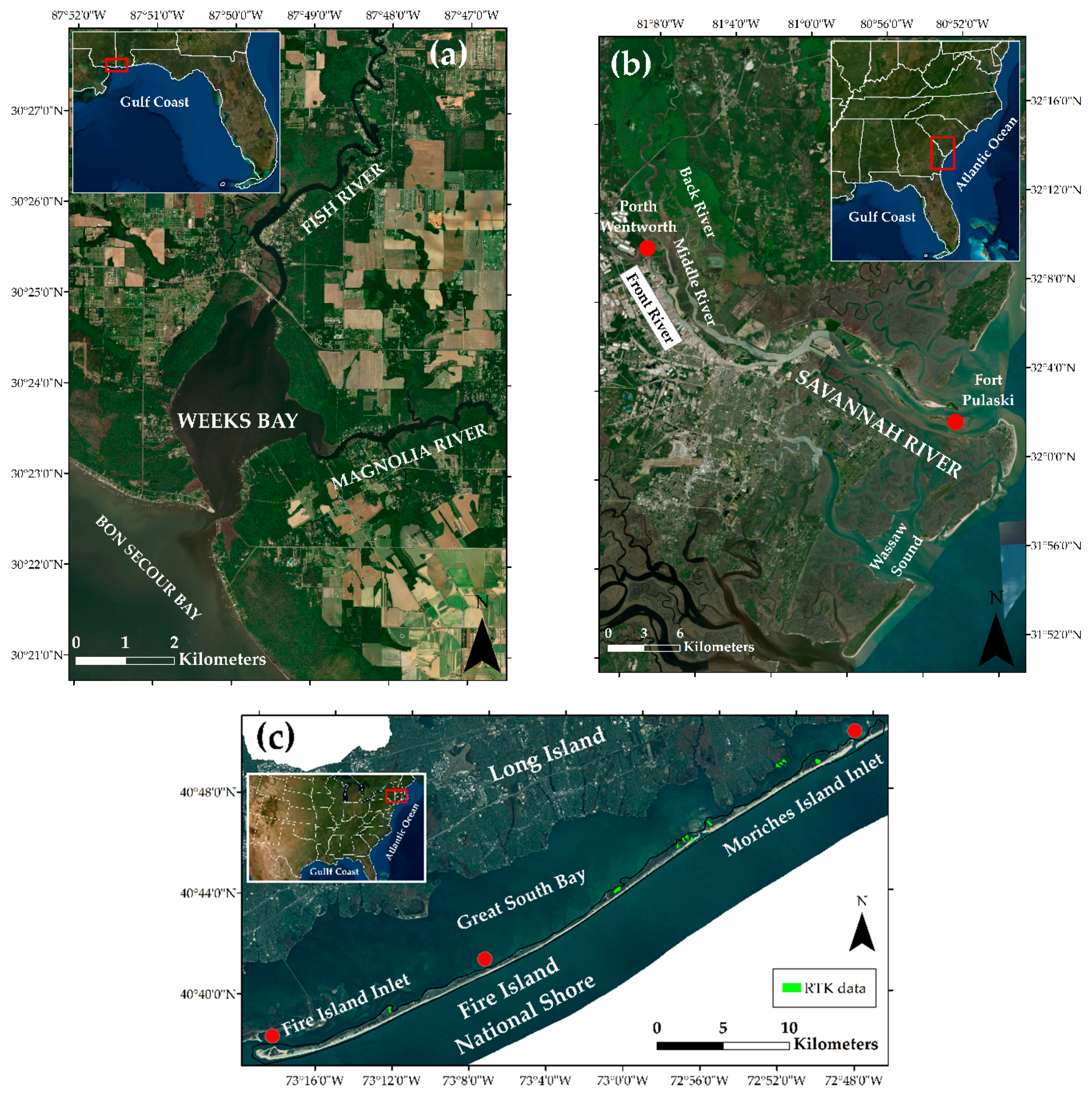
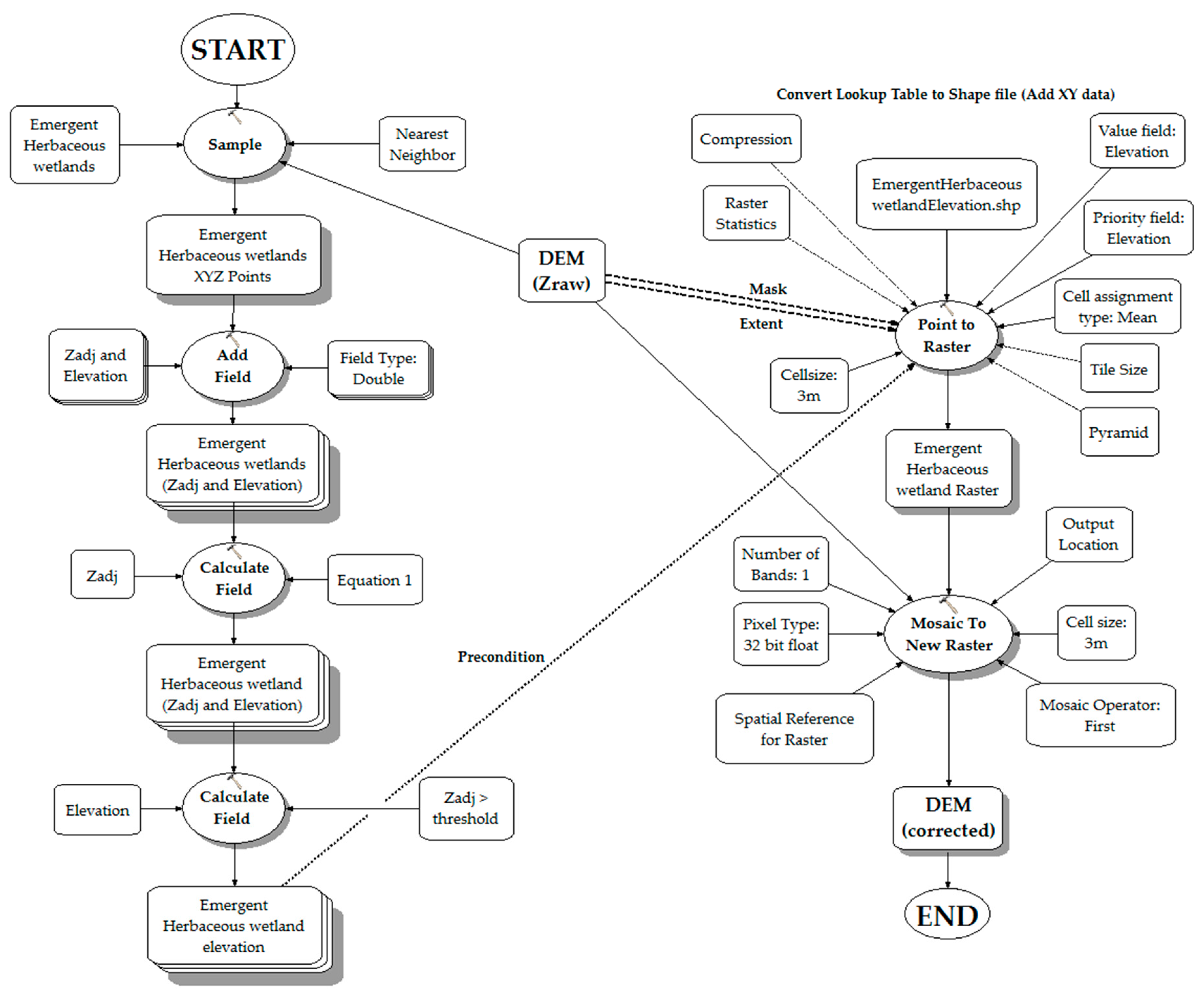
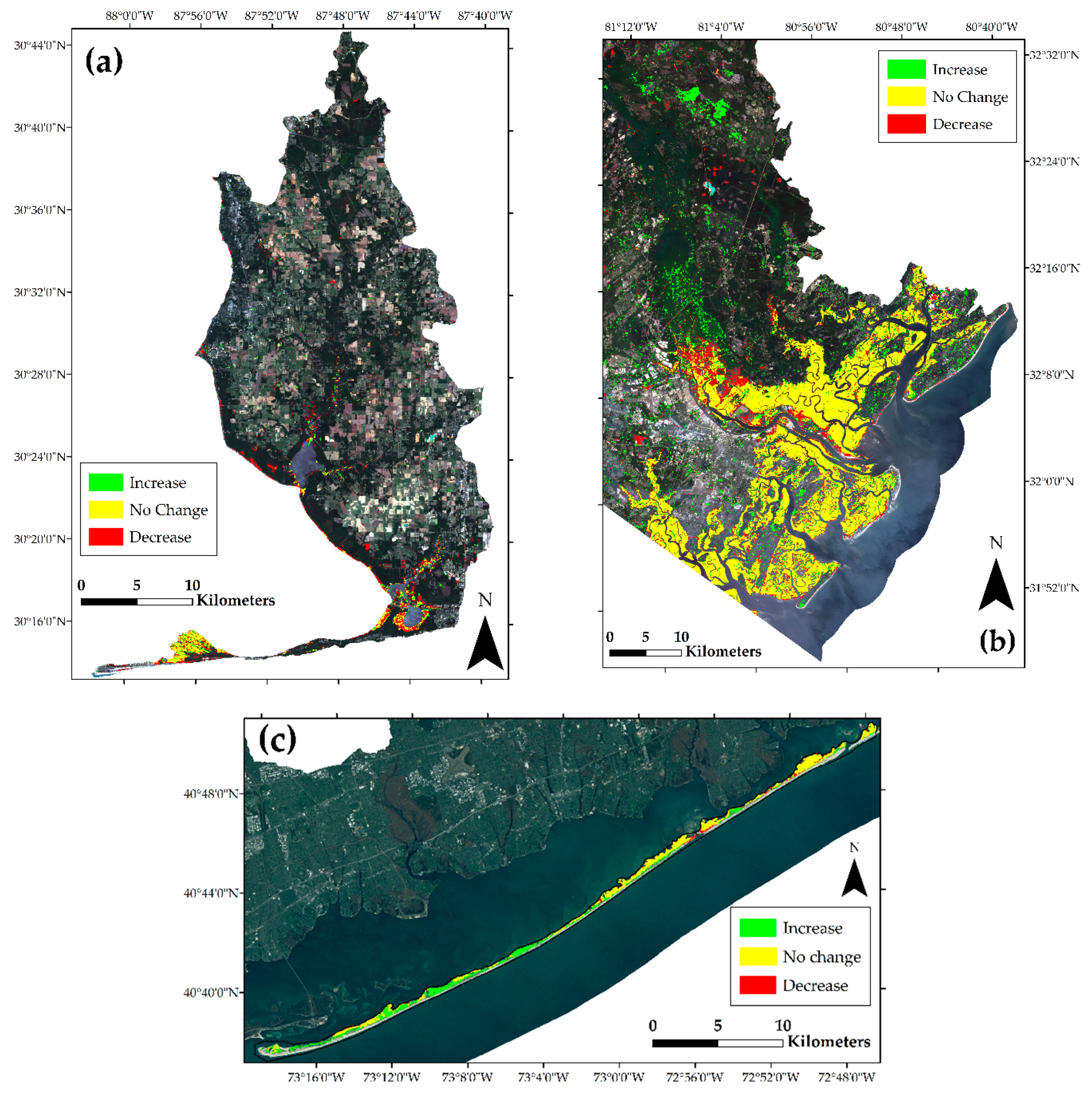
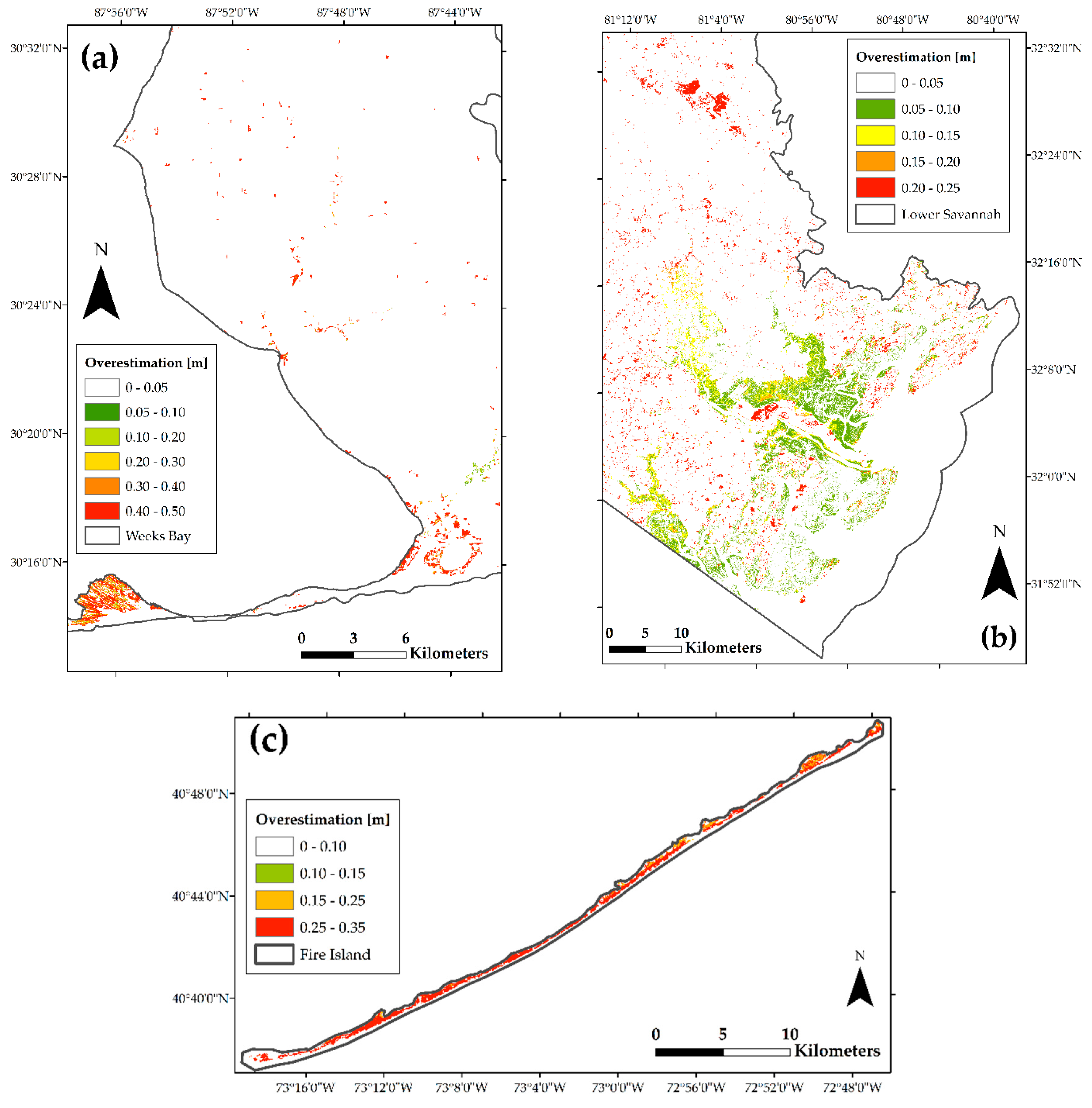
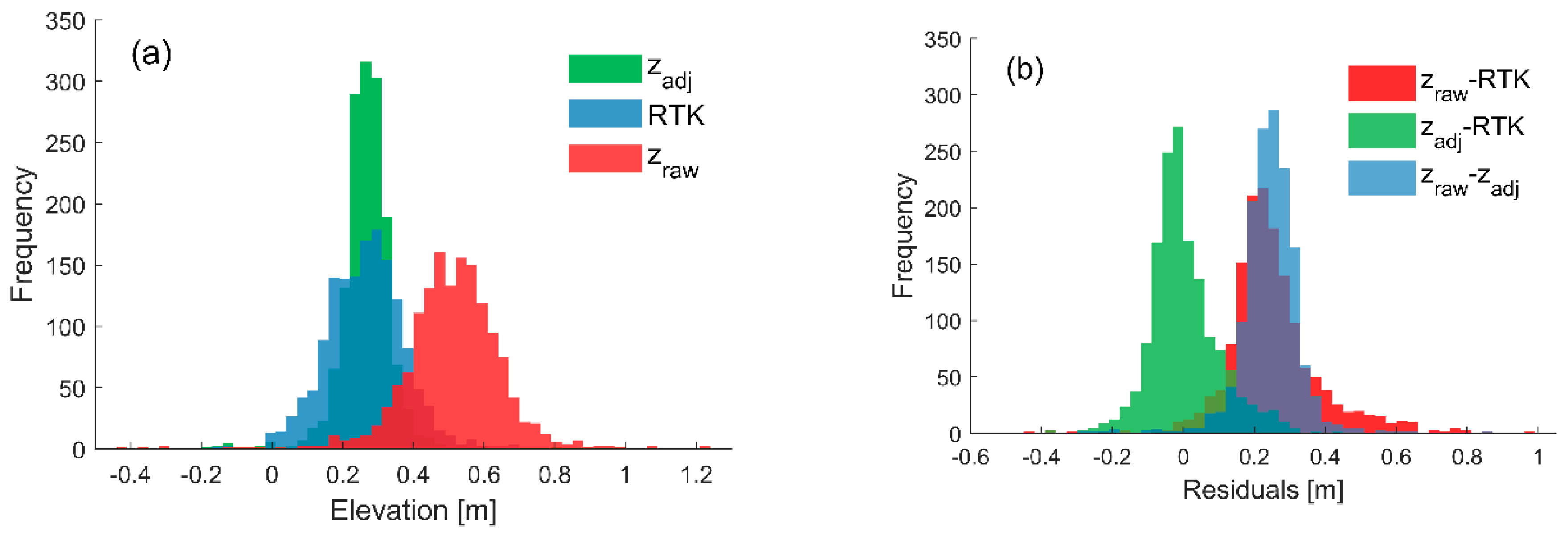
| NLCD (Reference) | Date | Landsat 8 OLI/TIRS § (Path/Row) | Landsat ARD # (Horiz./Vert.) | Tidal Stage * (Max/Min/Mean) (m) | Study Area |
|---|---|---|---|---|---|
| 2016/Mar/03 | 2016/Feb/28 | 20/39 | 22/16 | 0.14/–0.14/0.00 | Weeks Bay |
| N/A | 2019/Apr/16 | 0.21/–0.12/0.04 | |||
| 2016/May/17 | 2016/May/06 | 16/38 | 26/14 | 1.73/–1.48/0.19 | Savannah |
| N/A | 2019/Apr/29 | 0.86/–0.87/0.05 | |||
| 2016/Jun/17 | 2016/Jun/18 | 13/32 | 29/7 | 0.24/–0.19/0.02 | Fire Island |
| N/A | 2016/Apr/24 | 0.42/–0.09/0.16 |
| Features | Variables (p) | Expression |
|---|---|---|
| Reflectance (mean, SD, and range) | Multispectral band composition | Red; Green; Blue |
| NIR|; Green; Blue | ||
| Spectral indices (mean and SD) | Normalized Difference Vegetation Index (NDVI) | |
| Normalized Difference Water Index (NDWI) | ||
| Brightness Index (BI) | ||
| Enhanced Vegetation Index (EVI) | ||
| Normalized Difference Built-up Index (NDBI) | ||
| Specific Leaf Area Vegetation Index (SLAVI) | ||
| Green Ratio Vegetation Index (GRVI) | ||
| Ratio Vegetation Index (RVI) | ||
| Textural indices (mean and SD) | Contrast | Focal Statistics |
| Entropy | Haralick Texture | |
| Haralick correlation |
| Level 1 (L1) | Level 2 (L2) | Level 3 (L3) |
|---|---|---|
| Urban areas (1979/2097/135) | Developed, open space (797/736/21) | NA |
| Developed, low intensity (650/667/69) | ||
| Developed, medium intensity (444/417/36) | ||
| Developed, high intensity (88/277/9) | ||
| Non-urban areas (5639/5607/599) | Open water (504/873/203) | NA |
| Deciduous, Evergreen and Mixed forest (1028/1117/23) | ||
| Barren land, Grassland, Herbaceous, Pasture and Shrub (1887/1332/203) | ||
| Cultivated crops (882/516/NA) | ||
| Wetlands (1338/1769/170) | Woody (845/902/14) | |
| Emergent herbaceous (493/867/156) |
| Hyperparameter | Range | Total |
|---|---|---|
| Number of estimators | 100–600 | 5 |
| Maximum features | 10–20 | 5 † |
| Maximum depth | 30–50 | 4 |
| Minimum sample split | 2–6 | 3 |
| Minimum sample leafs | 3–7 | 3 |
| Bootstrap | True or False | 2 |
| Variable [m] | Dauphin Island, AL (8735180) | Fort Pulaski, GA (8670870) | Fire Island, NY (8510560) |
|---|---|---|---|
| Mean high water (MHW) | 0.207 | 0.938 | 0.205 |
| Mean sea level (MSL) | 0.018 | −0.071 | −0.101 |
| Mean lower water (MLW) | −0.151 | −1.170 | −0.426 |
| Upper tide range | 0.189 | 1.009 | 0.306 |
| Upper midpoint | 0.113 | 0.434 | 0.052 |
| Upper limit (u) | 0.396 | 1.947 | 0.511 |
| Lower limit (l) | 0.113 | 0.434 | 0.052 |
| zmax | 1.150 | 1.950 | 1.035 |
| zmin | 0.113 | 0.434 | 0.052 |
| Hyperparameter | Weeks Bay | Savannah | Fire Island |
|---|---|---|---|
| Number of estimators | 500 | 550 | 563 |
| Maximum features | 18 | 16 | 16 |
| Maximum depth | 37 | 37 | 49 |
| Minimum sample split | 4 | 4 | 4 |
| Minimum sample leafs | 5 | 3 | 3 |
| Bootstrap | True | True | True |
| Nomenclature Level | Description/Land Cover Class | Overall Accuracy | Class f1-score | f1-score Macro | Kappa Coefficient |
|---|---|---|---|---|---|
| L1 | Urban areas | (0.86/0.90/0.86) | (0.71/0.81/0.60) | (0.81/0.87/0.76) | (0.62/0.74/0.51) |
| Non-urban areas | (0.90/0.93/0.92) | ||||
| L2 | Developed, open space | (0.65/0.73/0.70) | (0.76/0.83/0.65) | (0.63/0.73/0.68) | (0.49/0.63/0.54) |
| Developed, low intensity | (0.55/0.66/0.72) | ||||
| Developed, medium intensity | (0.62/0.63/0.71) | ||||
| Developed, high intensity | (0.59/0.82/0.67) | ||||
| Open water | (0.73/0.75/0.87) | (0.93/0.96/0.95) | (0.75/0.73/0.76) | (0.65/0.67/0.82) | |
| Deciduous, Evergreen and Mixed forest | (0.64/0.65/0.37) | ||||
| Barren land, Grassland, Herbaceous, Pasture and Shrub | (0.74/0.70/0.88) | ||||
| Cultivated crops | (0.72/0.56/NA) | ||||
| Wetlands | (0.72/0.80/0.83) | ||||
| L3 | Woody | (0.91/0.97/0.95) | (0.93/0.97/0.69) | (0.90/0.97/0.83) | (0.80/0.95/0.66) |
| Emergent herbaceous | (0.88/0.97/0.97) |
| Residuals | Max. (m) | Min. (m) | Range (m) | ME (m) | SE (m) | RMSE (m) |
|---|---|---|---|---|---|---|
| zraw - RTK | 1.319 | −0.926 | 2.245 | 0.250 | 0.004 | 0.008 |
| zadj - RTK | 0.624 | −0.481 | 1.105 | 0.003 | 0.003 | 0.003 |
| zraw - zadj | 1.310 | −0.451 | 1.761 | 0.247 | 0.003 | 0.007 |
© 2019 by the authors. Licensee MDPI, Basel, Switzerland. This article is an open access article distributed under the terms and conditions of the Creative Commons Attribution (CC BY) license (http://creativecommons.org/licenses/by/4.0/).
Share and Cite
Muñoz, D.F.; Cissell, J.R.; Moftakhari, H. Adjusting Emergent Herbaceous Wetland Elevation with Object-Based Image Analysis, Random Forest and the 2016 NLCD. Remote Sens. 2019, 11, 2346. https://doi.org/10.3390/rs11202346
Muñoz DF, Cissell JR, Moftakhari H. Adjusting Emergent Herbaceous Wetland Elevation with Object-Based Image Analysis, Random Forest and the 2016 NLCD. Remote Sensing. 2019; 11(20):2346. https://doi.org/10.3390/rs11202346
Chicago/Turabian StyleMuñoz, David F., Jordan R. Cissell, and Hamed Moftakhari. 2019. "Adjusting Emergent Herbaceous Wetland Elevation with Object-Based Image Analysis, Random Forest and the 2016 NLCD" Remote Sensing 11, no. 20: 2346. https://doi.org/10.3390/rs11202346
APA StyleMuñoz, D. F., Cissell, J. R., & Moftakhari, H. (2019). Adjusting Emergent Herbaceous Wetland Elevation with Object-Based Image Analysis, Random Forest and the 2016 NLCD. Remote Sensing, 11(20), 2346. https://doi.org/10.3390/rs11202346





